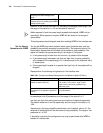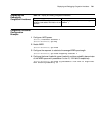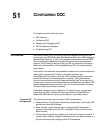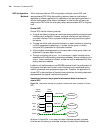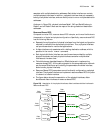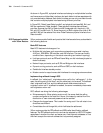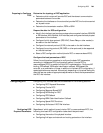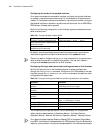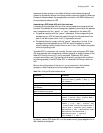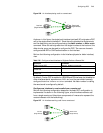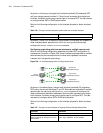708 CHAPTER 51: CONFIGURING DCC
As shown in Figure 225, a physical interface can belong to multiple dialer bundles
and hence serve multiple dialer interfaces, but each dialer interface associates with
only one destination address. Each dialer interface can use only one dialer bundle
that contains multiple physical interfaces having different priorities.
In Figure 225, Dialer2 uses Dialer bundle2, and physical interfaces Bri0, Bri1 and
Bri2 are members of Dialer bundle2. These physical interfaces have different
priorities. Suppose that Bri0 in Dialer bundle2 is assigned with the priority 100,
Bri1 with 50, and Bri2 with 75. Since the priority of Bri0 is higher than that of Bri1
and Bri2, Bri0 will be selected first when Dialer2 selects a physical interface from
Dialer bundle2.
DCC Features Available
with 3Com Routers
3Com routers provide flexible and practical dial interface solutions, as described in
the following sections.
Basic DCC features
Basic DCC features include support for:
■ Multiple dial interfaces, such as synchronous/asynchronous serial interface,
AUX port, ISDN BRI or PRI interface, and AM interface. The user can flexibly
combine them, depending on the actual networking and network topology.
■ Link layer protocols, such as PPP and Frame Relay, on dial interfaces (physical or
dialer interfaces)
■ Network layer protocols, such as IP, IPX and Bridge on dial interfaces.
■ Dynamic routing protocols, such as RIP and OSPF, on dial interfaces.
■ Flexible dial interface standby modes
■ Modem control on asynchronous dial interfaces for managing various modems.
Implementing callback through DCC
In callback, the “called party” originates a return call to the “calling party”. In this
case, the calling party is the client, and the called party is the server. The callback
client originates a call first, and the callback server determines whether to
originate a return call. If a callback is needed, the server immediately disconnects
and originates a return call.
DCC callback can bring the following advantages:
■ Enhances security: When placing a return call, the server dials the calling
number configured at the local end. Hence, the insecurity resulted from the
distribution of user name and password can be avoided.
■ Changes the charge bearer. This is useful for saving cost if the call rates in two
directions are different.
■ Consolidates the call charge bills, which facilitates the settlement.
3Com routers provide the PPP callback and ISDN caller identification callback
features. The PPP callback conforms to and can be adopted to a RFC1570 system
regardless of whether the client and server own fixed network addresses, or that
the client accepts the network address that is dynamically assigned.



